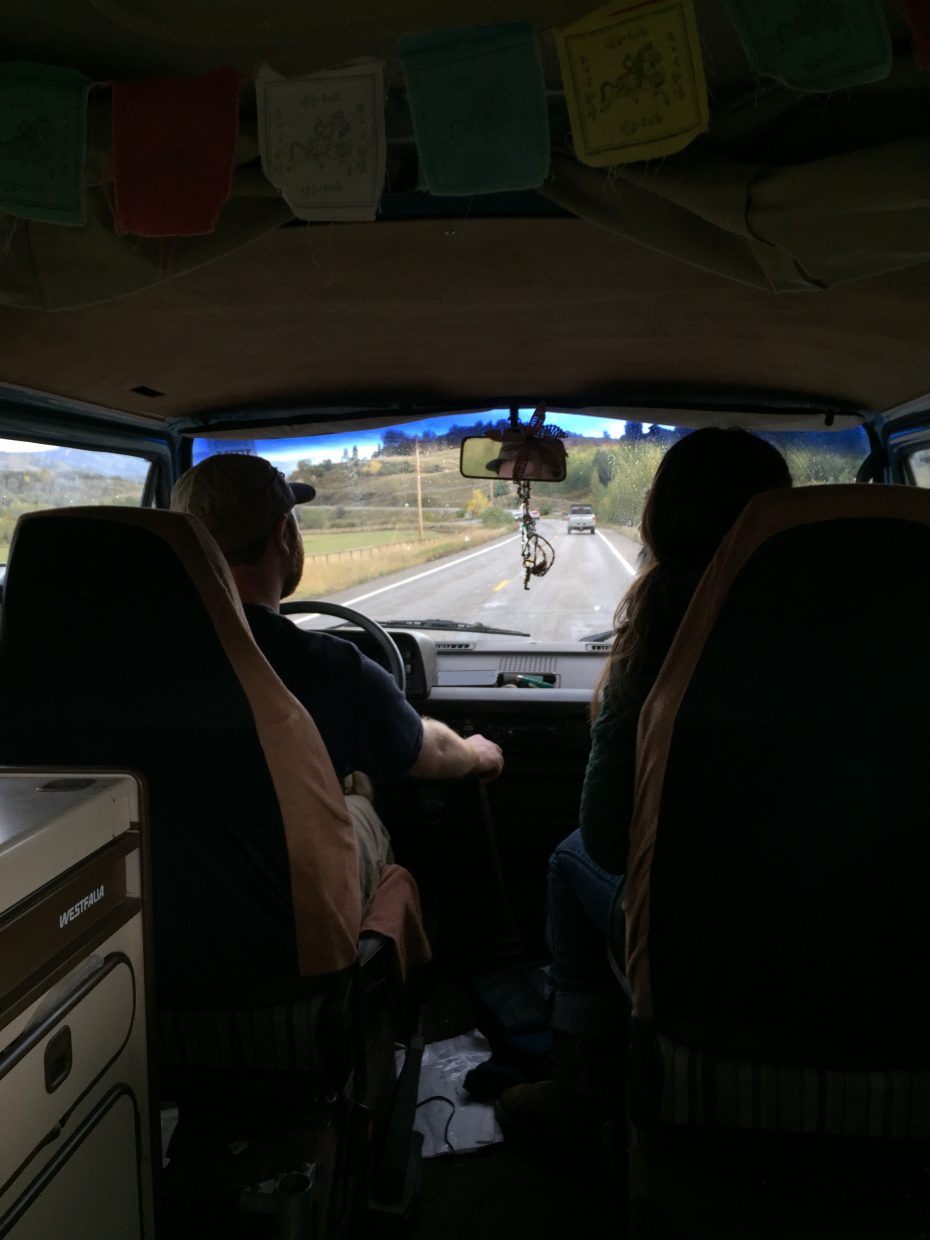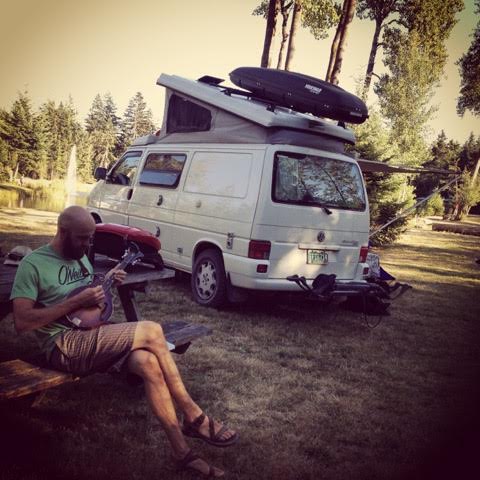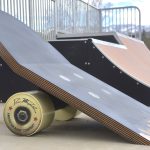Van Life: Who’s behind the wheel, what they’re up to and where local van life might be headed
It was their first night living full-time in their van.
That morning, Jes and Jason Striker had packed up the last few things in their 2000 VW Eurovan, waved Steamboat Springs “ta-ta” for now and headed northeast. Spirits were high and free; an itinerary for the foreseeable future was nonexistent. The adventure had begun.
As the van chugged its way down Poudre Canyon, the Strikers heard some unsettling noises, and the gauges went dead. They spent the night under the fluorescent lights of a Walmart parking lot in Fort Collins, waiting for a mechanic to open.
“But we were happy about it,” Jes said.
“We were so excited, it was unbelievable,” Jason said.
“This (breakdown) was just a little hiccup,” Jes said. “It doesn’t matter at all.”
They’d bought the van, called Pearl, several years before with the intent to camp and travel during weekends and vacations. But during a Fourth of July weekend with their van at Browns Park National Wildlife Refuge, they’d whimsically pondered, “Wouldn’t it be great if we could do this all the time?” “Yes, it would,” was the answer; and they realized, yes, it was possible.
The duo quickly went to work making full-time van living a reality. They set up a system to work remotely. They figured out how to deal with mail, bills and taxes. They held two massive yard sales and sold “almost literally everything,” Jes said. They started a blog, and they rented out their house.
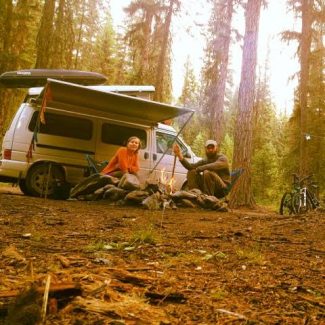 For the next three years, the Strikers were on the road. They mountain biked in British Columbia and Mexico and snowboarded through Alaska. When they got tired of driving, they surfed in Baja for a season. They parked the vehicle for a bit; they visited Sri Lanka and Greece, and maxed out European visas.
For the next three years, the Strikers were on the road. They mountain biked in British Columbia and Mexico and snowboarded through Alaska. When they got tired of driving, they surfed in Baja for a season. They parked the vehicle for a bit; they visited Sri Lanka and Greece, and maxed out European visas.
They traded out Pearl for a roomier rig. They visited family in New England. Jason got his paragliding license. They followed good weather. They got a dog.
When the Strikers set off on their adventure, they’d imagined that their van would be the lone van in many parking lots, that their blog would be pretty unique in its content of van life. But, as they rolled across the continent, they often found themselves in eye contact with another van driver in the rearview mirror or in the next lane or parked along the road on National Forest land for the night.
“We knew people did it,” Jes said, “but we were surprised we were so not alone.”

…
Madi King grew up on the stories of her parents.

“Before I was in the picture, they went to Alaska and lived out of a Toyota 4Runner for six months,” King said. “They’d tell me about how they’d drink coffee and beer out of the same mug and be able to go everywhere they wanted. I always thought that sounded incredible.”
During family trips, she’d sleep in the back of the truck with the bikes.
Once King got her driver’s license, she found herself gravitating toward the idea of living in a van. A neighbor spotted a classified ad for a van, and King ended up test driving it during her high school lunch period and buying it with every dollar she had.
“(A van has) always been a symbol of going on an adventure,” she said.
When King graduated from Steamboat Springs High School in 2016, she completed a three-month NOLS — National Outdoor Leadership School — course in the Pacific Northwest, during which she practiced living simply and resourcefully. Soon after, she and a friend took the van on a month-long roadtrip around the West, a test run for what was next: heading out to Wisconsin and taking on full-time van life as she worked as a river guide on the Menominee and Peshtigo rivers.
…
Scott Hendrickson had been fascinated with the tiny house movement and other forms of minimalist living for a while. After graduating college with a degree in natural resource management, he moved from Georgia to New Mexico for a job as a wildland firefighter. During the long drives between his old and new home, and for weekend adventures, he’d camp in his Chevy Avalanche truck, to which he’d added a platform bed and folding table.
Soon after Hendrickson moved to Steamboat for the winter to be a ski instructor, another driver lost control in the snow and hit Hendrickson’s truck, totaling it.
“But with every bad thing comes a good opportunity,” Hendrickson said.
He started searching for a four-wheel-drive van, but the promising Craigslist postings were pricey and were plucked off the market almost as soon as they went up. Hendrickson broadened his search and eventually came across a listing out of North Carolina for an ambulance.
…
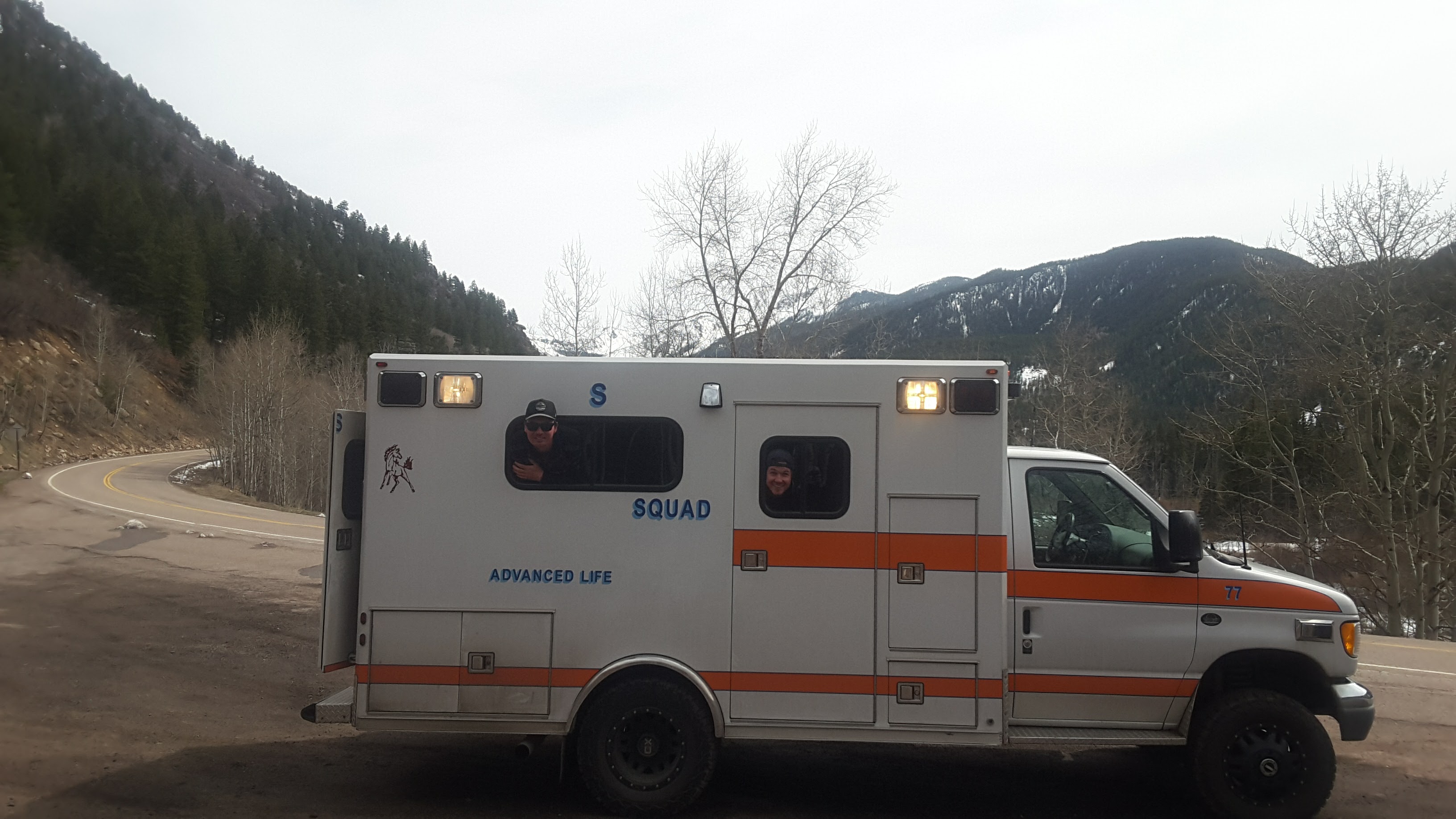
If you scroll through posts on Instagram that have been tagged #vanlife or #homeiswhereyouparkit, it becomes easier to see why some potential van-lifers might not truly grasp what they’re getting into.
The lifestyle appears on social media in nearly copycat images: smiles and a dog or two around a campfire, strings of decorative lights strung up above van windows, dinner cooking on a two-burner stove at sunset, surfboards and mountain bikes latched to the outside of a van, a silhouette in a yoga position on top of a van, two pairs of bare feet peeking out from a woven blanket, a van’s back doors open to a beach or mountain range.
“There’s a big misconception that (van life) is all beautiful,” Jes Striker said. “We did it to be closer to nature — we loved doing outdoor activities that much. But it’s a grittier environment than I think social media portrays it to be. We’ve definitely encountered people who didn’t know, and their van-life experience was short-lived.”
“We’ve met people who are professional Instagram celebrities,” Jason Striker said, referencing people who curate accounts featuring sponsored content and have thousands or millions of followers. “But it’s marketing, it’s an industry, not a true window into their lives. None of them post a picture of going into a Walmart at 2 a.m. to use the bathroom.”
“Half the reason I did van life was so that I could turn my phone off and unplug for weeks at a time,” Jes added.
Kathleen Morton lives in a 1987 van and has been doing van life for several years. She has more than 96,000 followers on her Instagram account Tiny House, Tiny Footprint, and runs a website of the same name that consists of a blog, podcast and resources for various types of minimalist, sustainable, off-grid living. She’s also the American representative to Vanlife Diaries, an online network of stories, photographs and resources related to van life.
“A lot of companies are realizing that there’s power in using people in the community to influence their brands,” Morton said. “It’s a no-brainer, in a way, to be partnering with us. We don’t own a lot of things, and several of us are very conscious about what we buy and the value it has on our lives. When we do purchase something, it’s a big deal.”
The social influencer market was estimated to be worth $500 million in 2015 and poised to increase to
$5 billion by 2020, according to Rachel Monroe, of The New Yorker.
…
Whether or not a van-lifer’s goal is to grow and monetize their brand, social media can play an important role in their van-life experience.

Madi King
Madi King, whose Instagram account has a following of 1,800, often gets messages from people asking if she thinks van life is something they could do and about her thoughts about interior layout strategies.
Part of Kathleen Morton’s social media presence is proactively creating content to help people figure out answers to those same questions.
“We’ve spent a lot of work being a good resource, a good hub, for the information that van-lifers need,” she said.
She and Vanlife Diaries are working on a documentary and a book about van-life experiences — works that are coming to fruition largely because of the company’s significant social media presence.
Besides technical information, there’s also a more personal community piece that some modern-day van-lifers find in social media.
“I had to get more comfortable with the internet (during van life),” Jes Striker said. “After a while, van life could get lonely. We’d see people on Instagram who had common interests and were on our same path. I’d always felt like meeting up was like a blind date and had some social anxiety about it, but we met some wonderful people. It was a breakthrough moment for me to realize you can actually meet people through social media.”
Shane Corrigan is a traveling sales representative for the outdoor gear company Wilcor, for which he often comes through Steamboat several times per work season. Where most traveling sales reps would expense hotel rooms along their routes, Corrigan says, he found himself more drawn toward living out of his Subaru and tent camping. Soon enough, he’d moved into a green 1976 Westfalia, which he’s been living in for six to eight months out of the year for the past four years.
“Instagram definitely helps people who are in the same area connect on the road,” Corrigan said. “But the neat thing about my van is that, even if I don’t exchange social media or contact information with someone, people will usually recognize (my van) when I’m in town, and we’ll be able to go for a bike ride or beer.”
…
No matter how a van-lifer hashtags about it — or if they opt to power off their devices entirely — there are pieces of van life that exist outside of social media.
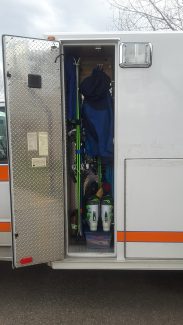 “If you’re just looking at the 20- and 30-somethings who are hashtagging ‘van life,’ they’re probably all pretty like-minded,” Jes Striker said. “But overall — if you walk into an RV campground in Cabo in the middle of winter, there’ll be people from all walks of life. There’s a lot of first names out there, people living off the grid. It can have a scary underbelly.
“If you’re just looking at the 20- and 30-somethings who are hashtagging ‘van life,’ they’re probably all pretty like-minded,” Jes Striker said. “But overall — if you walk into an RV campground in Cabo in the middle of winter, there’ll be people from all walks of life. There’s a lot of first names out there, people living off the grid. It can have a scary underbelly.
“We also met a lot of people raising their kids outside of the public school system. They’re able to offer such exposure — they want to show their children something different,” Jes added.
“It’s people who’ve looked at the standard way of life and said, ‘that’s not for me,’” Jason Striker said. “Part of this whole revolution is this generation (millennials) saying, ‘We don’t have to do exactly what society says we do: the marriage, kids and constant debt.’”
“More and more people can’t afford to pay rent, and van life has become an affordable housing solution to this,” Kathleen Morton said.
“I would say the majority of van-lifers I know are saving money living this lifestyle,” Morton said. “I surround myself with people in the community who enjoy being in nature and who want to take their time traveling. We camp in public land locations for several days at a time, which ends up saving money on gas and campground fees. We also aren’t purchasing as many items because we don’t need as many things. I think that spending $1,000 to $1,500 a month is reasonable.”
“It’s super inexpensive,” Jes Striker said. “We escaped the regular monthly utility bills for three years: no electric, gas, trash, water, sewer, internet. And rent / mortgage can now become free if you so choose and your location allows. If it wasn’t a cheaper lifestyle, there would be a fraction of people living in vehicles around the world.
“We met many folks living as cheaply as possible and would never even dream of paying to camp. We also crossed paths with a lot of others who chose to have the ‘luxury’ of plugging in at camp sites or RV parks that offer electric, water/sewer, even cable if that’s your thing. So there are very different ends of the life-on-the-road spectrum for sure.”
Shane Corrigan sees similarities of people who move to mountain towns and people who move into a van.
“It’s people who are sick of their 9-to-5 day job, city living, that’s the biggest trend,” Corrigan said. “I meet a lot of people in the same age group that I am — mid-20s — who are in between the after-college and the don’t-have-a-family-yet. It’s a lot of like-minded people trying to do the same thing: ski, bike, meet people and experience life.”
“After the first year or two years we were traveling, a friend asked how it was going,” Jes Striker said, “and I said, ‘I feel 10 years younger and 10 years wiser.’”
…
For Scott Hendrickson, who’s building out the ambulance named Gerty, the project itself has been a fulfilling adventure, with a steep learning curve and plenty of adjustments along the way.
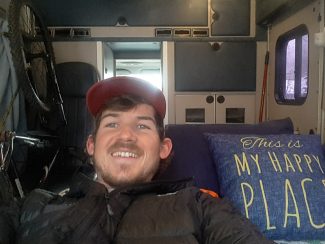 It took three sketchbooks of brainstorming layouts to reach a decision on how to do the build-out, and the wiring the ambulance arrived with has made some modifications tricky.
It took three sketchbooks of brainstorming layouts to reach a decision on how to do the build-out, and the wiring the ambulance arrived with has made some modifications tricky.
“Everything I do has to be meticulous in how I’ve thought it out,” Hendrickson said. “If I was going to do it again, I’d probably get a Mercedes Sprinter van.
“At the same time, I really am glad I was impulsive about getting my ambulance,” he said. “It’s a neat opportunity and a cool experience. Maybe I keep it forever, maybe I don’t. Either way, things come and go, but it’s all about the memories and experiences you make.”
Those memories and experiences may be best represented by the six pairs of skis and a snowboard that fit into the compartment that used to carry oxygen tanks, which he’s taken on ski trips across the West, and the area of the ambulance roof where he sleeps on mild nights of camping — the space that’s not covered by the ambulance lights or where, eventually, a solar energy system will be mounted.
“All the lights actually still work,” Hendrickson said. “I don’t use them on the road, but if I was in the woods and something came up on me, like a bear, I’d use the lights and sirens to scare it away.”
…
Madi King, the river guide, has gotten to the point of feeling fulfilled by the way she’s experiencing life in her van.

Madi King
“You have to put a lot of thought and work into it, and it’s uncomfortable at first, but it’s so worth it,” King said. “Comfort zones are interesting. It’s all what you get used to — now, living in my van has become comfortable.”
As much as King enjoys the independence and solo living that she gets out of van life, other people are part of what makes van life so good. She keeps a board in her van, which she invites those she meets along her journey to sign with their favorite quote.
“(Van life) is a really neat way to connect with other people — people who are curious about the adventure and who want to sit and enjoy the ambiance of my little abode,” she said. “I love the community van life is creating. It’s a really special community with so much knowledge and creativity and really stellar adventurers. I’ve learned a lot from people who’ve done van life.”
Mary and Paul, who are based in Wyoming and didn’t want their last names used, have had their VW van for the past 18 years, taking it on hiking-oriented trips for several weeks or months at a time. They also attended a van gathering in Steamboat in 2016.
“I’d say van life culture doesn’t really have a lot of boundaries, whether they’re in a van or camper or whatever they’re in,” said Mary, who’s 60. “There are no boundaries as far as age or what you’ve been doing with your life. There’s a lot of acceptance of how you want to do it.”
…
Dave Walsh owns Vanlife Customs, a custom van build-out company based in Denver, and he also lived and traveled in a Mercedes Sprinter van fulltime for a year. Before he accepts a project, he sits down with the van owner and talks with them about their intentions.
 “We want people to make educated decisions,” he said. “I try to make sure everybody understands what they’re getting into.”
“We want people to make educated decisions,” he said. “I try to make sure everybody understands what they’re getting into.”
Many of Walsh’s customers are in their mid-30s — some who are taking a year off from work, some who recently sold a house.
“A common theme when people come to the van world is that they don’t want an RV.; that’s too many gadgets and too many complex systems. They still want the amenities: a simple bed, to be able to cook and turn on the lights,” Walsh said.
Vanlife Customs works on two complete build-outs at a time, meaning a customer has brought in an empty van to be built into a living space from scratch, which takes eight to 10 weeks. A full build-out will usually cost a customer $30,000 to $50,000, Walsh said, depending on the amenities and material finishes they choose.
The company also does smaller projects, like installing solar electrical systems, windows, fans and metal bed frames for customers who are otherwise taking the DIY route to a build-out.
…
Other potential van-lifers are interested in testing the waters of van life for a short stint.
In addition to her work with Vanlife Diaries and Tiny House, Tiny Footprint, Kathleen Morton is also head of community with Native Campervans, a Denver campervan rental company that’s a partner of Vanlife Customs. In June, Morton organized and guided a two-week, six-van caravan Vanlife Adventure Tour across 1,500 miles of Colorado and Utah. It was the company’s first such tour.
Participants came from across the U.S. and were a variety of ages — some solo travelers, some couples, some families. Each participant paid $3,000 for their seat in a four-person van rental, outdoor adventure and group activities in national parks, monuments and hot springs, a welcome party, reserved camping spots, a van gathering and giveaways.
“A lot of people want to do van life, but they don’t know how to start and they’re nervous, and they might be lacking the community piece of van life,” Morton said. “So, we thought we could bring people together and be that resource: show them the experience without them having to do the planning, teach them how to build a fire, how to be comfortable in their space. No one had to worry about where they were going to sleep that night, which is one of the stressful parts of van life.”
When the caravan stopped in Steamboat Springs, they hiked, biked, sampled restaurants and floated the Yampa. After the tour, one participant went out and bought herself a van.
“That’s what we wanted to happen; that was kind of the point of it,” Morton said. “We wanted to spread awareness about van life.”
…
A space where van-lifers of all ages, backgrounds and level of van-life experience might find themselves together is a van festival.

Carbondale’s annual Van Life Rally began in 2012 as part of the 5Point Adventure Film Festival, featuring an open house display of livable vehicles with music and lawn games.
Syncro Solstice, an offroad event in east Moab that describes itself as the paragon of the VW Vanagon culture and experience, marked its seventh annual event in May. Eighty vans showed up for a weekend of outdoor adventure, van-related contests and conversations and an attempt to set a new van-stuffing record — fitting 29 adults into a Vanagon.
Buses by the Bridge, in Lake Havasu City, Arizona, markets itself as an event for “VW buses of all vintages and types,” accommodating as many as 500 vehicles on a first-come, first-serve basis. The four-day gathering features a Boy Scout pancake breakfast, a kids coloring contest and a corn hole tournament.
Three years ago, two Steamboat Springs couples founded Gathering of the Vans, a local van-life festival. Casey and Ali Gianfagna and John Miller and Sara Boyle lived in houses next door to each other and each had a van for weekend and vacation camping trips.
“Gathering of the Vans is a grassroots version of Syncro Solstice,” Casey Gianfagna said.
The first Gathering of the Vans event, three years ago under a red moon on Buffalo Pass, saw two VW vans attend, and several friends in cars and trucks who enjoyed camping and wanted to join.
The 2016 event, on Rabbit Ears Pass, saw a dozen VW vans and 10 vans of other brands. Van-lifers went on mountain bike rides, brought potluck dishes to community meals, played music and had a campfire surrounded by three dozen van and camping enthusiasts, according to John Miller.
“We’re not trying to be elitist,” John Miller said. “There was a Honda CRV that showed up to one — I called it the Honda CRVan.”
“The bigger and more organized these festivals are, the less open they are to people who are in other kinds of vans,” Ali Gianfagna said. “We let everyone come camp.”
…
“Van life is a pretty big thing I didn’t really see coming,” Shane Corrigan said, “but now it’s this whole craze. It definitely seems to be more and more popular each year. The first year I did it, people were pretty confused and were questioning my decision all the time; now, everyone’s open to it and wants to know more. The mindset is definitely changing, especially in Colorado.”

Burning Van 2017 in Routt National Forest
“Access to National Forest or BLM land makes van life better out here, in Colorado, Utah, the Pacific Northwest and California,” Kathleen Morton said. “It goes hand-in-hand with the van-life community being bigger out here — it’s nice to have that community piece.”
“Van life has existed for a while, but in the last three years, it’s gotten a lot more prevalent,” Mary said. “At least, there are a lot more people who I see talking about it. Maybe that’s more people doing it, or maybe there’s more people discussing it.”
In northern Wisconsin, Madi King said she and her van still stick out like a sore thumb.
“I have stickers about ohm and the mountains,” she said. “As a guide, I talk to a lot of people, and they’re usually pretty intrigued about van life; but when I venture out (of the river camp), I definitely get a lot of looks, and people are like, ‘Who’s that hippie in the van?’ It’s not something a lot of people do out here.
“It’s great how supportive people are of van life in the West, and in Steamboat especially,” King added. “It’s like, ‘Rock on, you’re living out of a van.’”
…
On the other end of the spectrum, Dave Walsh notes some ways that the lifestyle might be outgrowing itself.

Burning Van 2017 in Routt National Forest
“Van life is getting a little trickier for folks with more people doing it,” Walsh said. “In Steamboat, you’re fine if you’re going up to National Forest area and following the rules, but in towns and cities, especially in the Front Range, people are realizing that people are living in these vans. There’s always the question, ‘Am I pulling my weight in my community?’ In any population, you’re going to have people who take advantage of it, and people are starting to frown upon van life. That makes it harder for everybody to stay stealthy.”
Even with the abundance of land close to Steamboat city limits that allows car camping, police have seen a recent uptick in people sleeping overnight in their vehicles on public property, which is prohibited under city ordinances.
“This summer was one of our highest number of citations of people sleeping in their vehicles. Not necessarily at campsites, but in the city,” said Officer Isis Adams, of the Steamboat Springs Police Department. “If you’re going to do it, at least do it in a legal camping space.”
Public property, where sleeping overnight or living in a vehicle is prohibited, includes city streets, the Stockbridge Transit Center, city parks and public parking lots.
“I’ve probably only been asked to move maybe twice in the four years,” Shane Corrigan said. “The police have been very kind but for the most part I’ve been pretty much left alone. In my experience, it’s all been really positive. I hope it doesn’t get spoiled.”
…
Van life as a social phenomenon seems to have revved its engine and gained significant attention, for better and for worse. So what’s down the road for this lifestyle?
 Walsh and his fellow workers in the van build-out world speculate on the future of the industry.
Walsh and his fellow workers in the van build-out world speculate on the future of the industry.
“We’re having a tough time predicting what’s going to happen,” he said. “If we’re in a financial bubble right now, what’s going to happen is it’s going to pop and then our industry could die off. The weekend warriors would stop buying vans, but we’d also see an uptick in the people living in their van full-time, because it’s cheaper than buying a house.”
…
Jes and Jason Striker are now almost half a year into their transition back into their house in Steamboat Springs after full-time van life. The first few weeks, they were thrilled at the ease of taking a shower, cooking and laundry.
“We domesticated immediately,” Jes Striker said.
Then slowly the feelings of nostalgia about van living — of sleeping under the stars and the little things — came creeping back in.
“Right now, I know what I’m going to do this winter and next summer,” Jes said. “But there’s excitement to not knowing. I miss the uncertainty.”

Support Local Journalism

Support Local Journalism
Readers around Steamboat and Routt County make the Steamboat Pilot & Today’s work possible. Your financial contribution supports our efforts to deliver quality, locally relevant journalism.
Now more than ever, your support is critical to help us keep our community informed about the evolving coronavirus pandemic and the impact it is having locally. Every contribution, however large or small, will make a difference.
Each donation will be used exclusively for the development and creation of increased news coverage.

